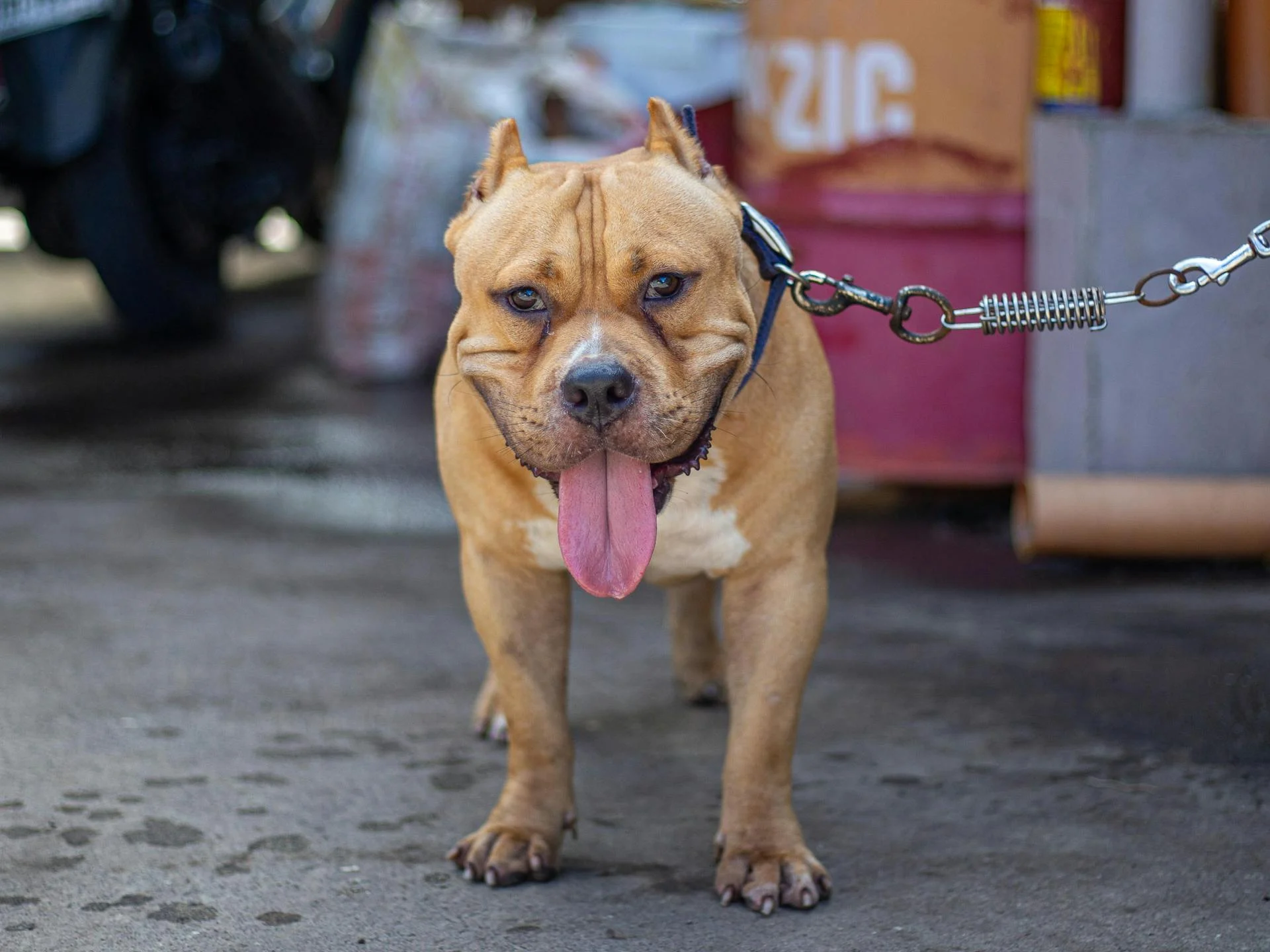
American Bully food allergies can be a real challenge for pet owners. According to our research, some common food allergens in American Bullys include beef, dairy, and chicken.
Identifying the allergen is key to managing the allergy. This can be done through a process of elimination, where you remove potential allergens from the dog's diet one by one.
Symptoms of food allergies in American Bullys can be mild to severe and may include skin issues, digestive problems, and ear infections. In severe cases, anaphylaxis can occur.
Consulting with a veterinarian is essential in determining the best course of action for managing your American Bully's food allergy. They can help you develop a plan to eliminate the allergen and ensure your dog's nutritional needs are met.
Understanding Allergies
Allergies in American Bullies can be a real challenge to manage, but understanding what they are and how they manifest can make a big difference. Allergies are an overreaction of the immune system to a specific substance, in this case, food.
Most dogs with food allergies react to one or two allergens, with some even reacting to more. Animal products from the same species or related species, such as cattle, sheep, and deer, are more likely to trigger an allergic reaction.
Some breeds, like Cocker Spaniels, Labrador Retrievers, and German Shepherd Dogs, may be more prone to food allergies, but any breed can be affected. In fact, nearly 8% of dogs presented to a referral dermatology practice had food allergies.
Common signs of food allergies in American Bullies include itchiness, hair loss, and redness. If your dog is experiencing these symptoms, it's essential to consult with a veterinarian to determine the best course of action.
Here are some common allergens that can affect American Bullies:
- Chicken
- Beef
- Wheat
- Corn
- Soy
- Dairy products
Remember, diet trials can be inconvenient, but they're a small price to pay to identify the culprit and get your dog on the road to recovery.
Allergies vs. Sensitivities
Food allergies and sensitivities can be a real challenge for our furry friends. True food allergies are much less frequent than food sensitivities and reflect a more immediate immunological response.
A classic example of a food allergy is anaphylactic shock, which could occur after ingesting peanuts or being stung by bees. This response is rapid, as the antigen triggers an immediate and sometimes life-threatening reaction due to hypotension and shock.
Food sensitivity, on the other hand, is usually a chronic condition and often doesn’t involve an immunological response. It’s usually a cumulative response to an offending agent.
Symptoms of food sensitivity include diarrhea with or without vomiting, poor skin or itchy coat, and chronic ear or foot infections.
Here are some common signs of food sensitivity:
- Diarrhea with or without vomiting
- Poor skin or itchy coat
- Chronic ear or foot infections
It's worth noting that most dogs react to one or two allergens and about 20% react to more. There’s a greater chance that dogs react to animal products from the same species or from related species, such as cattle, sheep, and deer.
Recognize Health Issues
If your dog is experiencing itchy skin, it's not just a minor annoyance - it can be a sign of a food allergy. In fact, about 35% of dogs with food allergies suffer from itchy armpits, anterior foreleg, or eye regions.
Itchiness is just one of many symptoms of food allergies in dogs. You may also notice loose stools, vomiting, or belching. In severe cases, secondary ear and skin infections can arise from self-inflicted trauma.
Some breeds, such as Cocker Spaniels, Labrador Retrievers, and German Shepherd Dogs, are more prone to food allergies. But any dog can develop an allergy at any age.
If you notice your dog is experiencing any of the following symptoms, it's essential to contact your vet for a check-up:
- Loss of appetite
- Weight gain/loss
- Lethargy
- Itchiness
- Coughing
- Sneezing
- Vomiting and diarrhea
- Panting and drooling
- Constipation
Don't wait until it's too late - regular monitoring can help you catch health issues early on, and a diet trial can be a crucial step in identifying the culprit behind your dog's symptoms.
Causes and Symptoms
Food allergies in American Bullies can be a real challenge to diagnose and manage. About 10% to 15% of dogs with food allergies will have both skin and GI signs, and about 20% to 30% of dogs with food allergies will also have itchy skin from other non-food allergies.
GI signs are often seen as loose stools, with an average of three a day, or vomiting and belching. Itchiness is usually a skin sign, appearing the same as itchiness due to other allergies.
Some breeds, such as Cocker Spaniels, Labrador Retrievers, Golden Retrievers, German Shepherd Dogs, Poodles, and Chinese Shar-Pei, may be at greater risk for food allergies, though they can appear in any breed.
Most dogs react to one or two allergens and about 20% react to more. There's a greater chance that dogs react to animal products from the same species or from related species (cattle, sheep, and deer, for example).
For your interest: Do Labrador Retrievers Drool
It's essential to note that allergies can appear at any age, but most dogs eat an offending food for two years before symptoms appear. Some dogs can develop symptoms as early as two months of eating the offending food.
Here are some common symptoms of food allergies in American Bullies:
- Loose stools (average of 3 per day)
- Vomiting and belching
- Itchiness (skin sign)
- Itchy ears (80% of cases)
- Itchy feet (61% of cases)
- Itchy groin region (53% of cases)
- Itchy armpits, anterior foreleg, or eye regions (35% of cases)
Secondary ear and skin infections often arise from self-inflicted trauma from scratching and chewing, so it's crucial to seek treatment for these infections along with removing the offending food.
Diagnosing and Treating
Diagnosing and treating food allergies in American Bullies can be a process, but it's worth it to get to the bottom of your dog's discomfort. Most dogs react to one or two allergens, and about 20% react to more.
Diet trials can be inconvenient and tedious, but they're a crucial step in identifying the culprit. Unfortunately, there is no cure for food allergies – except to avoid the offending foods.
Some breeds, like Cocker Spaniels, Labrador Retrievers, and German Shepherd Dogs, may be at greater risk for food allergies, but they can appear in any breed. Your American Bully's risk doesn't necessarily mean they'll develop allergies.
Testing for allergies can be done through an environmental allergy test, food allergy test, or a food allergy elimination diet. A saliva test, which can be run by a holistic veterinarian or done at home with a kit, can measure antibodies to common food allergens.
The symptoms of food allergies can be sudden and serious, so it's essential to act quickly if you suspect an issue. Allergic reactions aren't something that normally appear immediately after introducing a new food, but once symptoms appear, they can be a sign that your dog needs a change.
See what others are reading: Dog Gut Health Test
Managing Allergies
Managing allergies in American Bullies requires patience and persistence. Allergies can appear at any age, but most dogs eat an offending food for two years before symptoms appear.
Some breeds, such as American Bullies, may be at greater risk for food allergies, though they can appear in any breed. Individual American Bullies can be allergic or build an intolerance to certain foods such as chicken, beef, wheat, corn, soy, or dairy products.
A food elimination diet is a non-invasive way to test for your dog's trigger food. This takes time (4 to 6 months) as you take your dog's diet back down to bare essentials, removing all the common allergens listed in the Common Food Allergens chart.
Here's an interesting read: American Bully Raw Diet
Hot Spots
Hot Spots are a type of dermatitis that leads to inflamed, red skin spots with pus. They're often caused by allergies, stress, or bacterial infection.
You might notice your dog trying to chew or lick the affected area, which can worsen symptoms. This is because the skin is highly sensitive and irritated.
About 80% of dogs with food allergies suffer from itchy ears, and in some cases, the ear is the only affected area. This can lead to secondary ear infections if not treated properly.
Hot spots can be painful and uncomfortable for your dog, so it's essential to seek veterinary attention to prevent further complications.
Explore further: Do Goldendoodles Get Hot
Diet Changes Can Help
Changing your dog's diet can be a game-changer for managing allergies.
About 10% to 15% of dogs with food allergies will have both skin and GI signs, and about 20% to 30% of dogs with food allergies will also have itchy skin from other non-food allergies.
Diet trials can be inconvenient and tedious, but they're a small price to pay to identify the culprit. Unfortunately, there is no cure for food allergies—except to avoid the offending foods.
Switching from a processed kibble to a raw or home-cooked diet can help reduce the amount of additives, grains, and artificial components in your dog's diet.
Some breeds, such as Cocker Spaniels, Labrador Retrievers, Golden Retrievers, German Shepherd Dogs, Poodles, and Chinese Shar-Pei, may be at greater risk for food allergies, though they can appear in any breed.
Common allergens include chicken, beef, wheat, corn, soy, or dairy products, which can manifest themselves through itchiness, hair loss, and redness.
A food elimination diet is another non-invasive way to test for your dog's trigger food, taking time (4 to 6 months) as you take your dog's diet back down to bare essentials, removing all the common allergens.
Additional reading: American Bully Puppy Diet
Frequently Asked Questions
What is the best dog food for bullies with allergies?
For American Bullies with allergies, Purina Pro Plan Sensitive Skin and Stomach Dog Food is a great option that addresses stomach sensitivities and skin issues. This salmon and rice formula is a thoughtfully crafted meal that takes your dog's dietary needs to heart.
Sources
- https://bondvet.com/b/chicken-allergy-in-dogs
- https://www.akc.org/expert-advice/health/dog-food-allergies/
- https://dogsbestlife.com/dog-breeds/american-bully-health-issues/
- https://www.dogsnaturallymagazine.com/5-signs-your-dog-has-food-allergies/
- https://www.bestbullysticks.com/blogs/bbs-blog/what-cant-dogs-eat
Featured Images: pexels.com


